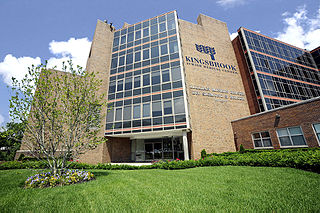Related Research Articles

Bay Ridge is a neighborhood in the southwest corner of the New York City borough of Brooklyn. It is bounded by Sunset Park to the north, Dyker Heights to the east, the Narrows and the Belt Parkway to the west, and Fort Hamilton Army Base and the Verrazzano-Narrows Bridge to the south. The section of Bay Ridge south of 86th Street is sometimes considered part of a sub-neighborhood called Fort Hamilton.

Dyker Heights is a predominantly residential neighborhood in the southwest corner of the borough of Brooklyn in New York City. It is on a hill between Bay Ridge, Bensonhurst, Borough Park, and Gravesend Bay. The neighborhood is bounded by 7th and 14th Avenues, 65th Street, and the Belt Parkway on the west, east, north, and south, respectively.

Saint Vincent's Catholic Medical Centers was a healthcare system in New York City, anchored by its flagship hospital, St. Vincent's Hospital Manhattan.

Adventist Health Portland, is a 302-bed hospital serving 900,000 residents on the east side of the Portland-Vancouver metropolitan area in the United States. It is the primary teaching hospital of the Walla Walla University Nursing program.

NYU Langone Hospital – Brooklyn is a full-service, 450-bed academic teaching hospital in the Sunset Park neighborhood of Brooklyn, New York City. Formerly named NYU Lutheran Medical Center, it functions as the hub of Lutheran Healthcare, which itself is part of NYU Langone Health, which is one of the largest healthcare systems in the Northeast.
The town of Colorado Springs, Colorado, played an important role in the history of tuberculosis in the era before antituberculosis drugs and vaccines. Tuberculosis management before this era was difficult and often of limited effect. In the 19th century, a movement for tuberculosis treatment in hospital-like facilities called sanatoriums became prominent, especially in Europe and North America. Thus people sought tuberculosis treatment in Colorado Springs because of its dry climate and fresh mountain air. Some people stayed in boarding houses, while others sought the hospital-like facilities of sanatoriums. In the 1880s and 1890s, it is estimated that one-third of the people living in Colorado Springs had tuberculosis. The number of sanatoriums and hospitals increased into the twentieth century. During World War II, medicines were developed that successfully treated tuberculosis and by the late 1940s specialized tuberculosis treatment facilities were no longer needed.

The Knickerbocker Hospital was a 228-bed hospital in New York City located at 70 Convent Avenue, corner of West 131st Street in Harlem, serving primarily poor and immigrant patients.

Kingsbrook Jewish Medical Center was a 303-bed full-service community teaching hospital with an estimated 2,100 full-time employees, located in the neighborhood of East Flatbush in Brooklyn, New York. The hospital was made up of a complex of eight conjoined buildings which are dispersed over a 366,000 square foot city block.
The Brooklyn Jewish Hospital and Medical Center was an academic, sectarian hospital in Crown Heights and Prospect Heights in Central Brooklyn. It merged with St. John's Episcopal Hospital to form Interfaith Medical Center in 1983.
Joel Landau is an American entrepreneur and health care expert. He is the founder of the Allure Group, which specializes in purchasing and improving nursing homes and rehabilitation facilities in the United States that are in danger of closing, and AlphaCare company.
Victory Memorial Hospital was a 254-bed medical facility. It was announced in 2006 that they're closing; they were acquired by SUNY Downstate Medical Center in 2009 and renamed SUNY Downstate at Bay Ridge.

Adelphi Hospital was a 146-bed voluntary hospital that opened in 1929 at 50 Green Avenue and closed in 1974. It "served the Fort Greene section of Brooklyn." The hospital was in "a seven-story, fireproof building" and was located at "the corner of Greene Ave and Adelphi St."
Midwood Hospital opened in 1907 as Midwood Sanitarium. It closed in the 1970s, and its building served as a private school from 1979 thru 2000.
References
- ↑ "BAZAAR TO AID HOSPITAL.; Fair for Bay Ridge Institution". The New York Times . October 12, 1919.
The Women's Auxiliary of the Bay Ridge Hospital has arranged to hold a bazaar on Oct. 17 and 18 in the hospital building, Seventh Avenue and Ninetysecond Street
- 1 2 "Mr. Charlie and the Spices of His Life". New York Times . April 6, 2008.
I was born right here in Bay Ridge Hospital, which is now St. Nicholas Home for the elderly.
- ↑ "Where to Find Medical Records for Closed Hospitals in New York State" (PDF).
Bay Ridge (Now a nursing home), 437 Ovington Avenue, Brooklyn, NY 11209
- 1 2 3 4 "The Fights for Bay Ridge's First Hospitals". March 27, 2017.
- ↑ "memorial". Brooklyn Eagle . February 25, 1919. p. 2.